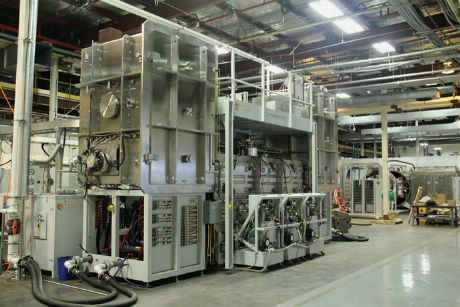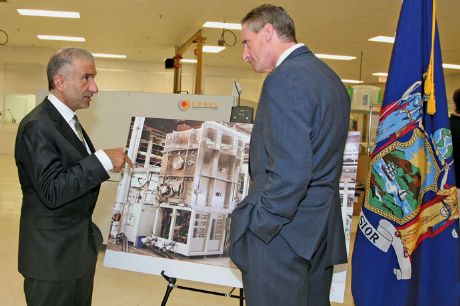Development of new solar energy technologies figures to be a major driver in the economy of Upstate New York in the coming years. Collaboration between the U.S. Photovoltaic Consortium (PVMC) and Hudson Valley-based Ceres Technologies is the latest step in the industry’s advancement. Participants project that the US$20-million deal will create more than 250 jobs in the region over the next five years.
The PVMC is a $400-million consortium for cooperative R&D among industry, university and government partners to accelerate the development, commercialization, and manufacturing of next-generation solar photovoltaic (PV) systems. The PVMC has access to the programs, talent and advanced manufacturing development facilities at SUNY Albany’s College of Nanoscale Science & Engineering (CNSE) and SEMATECH and has become a proving ground for innovative solar technologies and manufacturing processes.
For Ceres, a provider of support equipment to the semiconductor and solar sectors, the partnership represents an opportunity to solidify its stature in the state’s burgeoning solar sector. The relatively new company is located less than an hour from the CNSE campus.
Kevin Brady, president and CEO of Ceres Technologies, says his company’s location just south of SUNY Albany has allowed it to develop an ongoing relationship with CNSE.
“We provide a variety of equipment on the semiconductor side as well as to SEMATECH,” Brady says. “As they started to embark on the solar effort, we expressed an interest in being a part of that.”
Ceres was a supplier to Veeco, an equipment manufacturer supplying the PVMC. Veeco’s announcement of its exit from the solar business last summer was followed by CNSE’s October 2011 takeover of Veeco’s facility and PVMC’s plan to use it for thin-film prototyping. Ceres bought Veeco’s product line in February 2012 and subsequently began working with the consortium.
Ceres currently employs 80 people split between its 65,000-sq.-ft. (6,038-sq.-m.) manufacturing facility in Saugerties, N.Y., and its 10,000-sq.-ft. (929-sq.-m.) high-bay manufacturing site in Kingston, N.Y. Ceres was formed in October 2011 as a spin out of Precision Flow Technologies, a contract manufacturer for the semiconductor and solar industries.
Brady says 70 percent of Ceres’ customers are in the semiconductor, solar and LED industries. He is bullish on the future of the New York’s solar industry.

“New York State is very keen on developing and promoting a robust infrastructure that will support manufacturing of solar devices as well as semiconductor devices,” Brady says. “From our perspective, plugging into the narrative is quite important to us. In general, New York State has been successful in getting that message out. We have seen a fair amount of response from industry folks, even from outside of the state. Internationally, even as far away as China, our customers seem to be aware of the technology development going on in this region.”
Ceres will join PVMC as a core member and serve as a key partner in establishing an advanced manufacturing development facility at CNSE to enable rapid prototyping of innovative solar devices. PVMC is part of the national effort to reduce the cost of installed solar energy systems from $5 per watt to less than $1 per watt over the next 10 years.
Ceres will provide to PVMC two vacuum thin-film deposition tools that are critical for manufacturing advanced solar cell devices on flexible substrates using copper indium gallium selenide, known as CIGS-based PV technologies. These CIGS-based solar cells represent the next generation of solar photovoltaics, offering improved performance at a reduced cost to manufacture and install.
Ceres has been awarded $764,000 in Excelsior Tax Credits by Empire State Development through the Mid-Hudson Regional Economic Development Council to assist the partnership. The partnership is projected to create 75 jobs for both Ceres and the CNSE, and an estimated 100 jobs at suppliers in the region.
“This significant expansion shows that the investments we have made in nanotechnology research in the Capital Region are generating economic growth and creating jobs across the state,” said Gov. Andrew Cuomo at the Aug. 29 announcement. “This new public-private partnership shows how government is working with the private sector to invest in our state and grow our economy. We look forward to continuing to partner with the private sector to expand nanotechnology in every region of the state.”
‘The Opportunity is Huge’
Dr. Pradeep Haldar, CNSE’s vice president for clean energy programs who serves as the COO and CTO of the PVMC, says Ceres is a natural fit for working with the consortium due to its proximity and its status as a major supplier to the industry. He says both the PVMC and Ceres are contributing to the collaboration’s funding. Haldar says the PVMC is trying to set up a large-scale manufacturing line for thin-film PV modules and systems.
“The intention is to allow companies to use it as a test bed for research and development and new processes,” Haldar says. “Ceres is providing about a half dozen tools on the front end of the line and another set of equipment on the back end.”

Haldar expects the CNSE to partner with other companies in the solar sector.
“We are slowly signing up more partners across the supply chain in the solar industry so that we can build a robust supply chain.”
Haldar says that while the solar sector has been shaky and has been hurt significantly by the stagnant economy, there is reason for optimism.
“The market demand signs continue to grow exponentially, not just in the U.S., but worldwide. There have been some shakeups in the industry, but it’s moving forward, and the strong companies will provide the leadership. The industry needs the kind of consortium that we have established here. That in itself will help the manufacturing and supply chain guys become stronger and move through the shaky economy.”
Establishing an infrastructure is key for the industry’s health and the New York State government has taken steps in that direction, Haldar says.
“Governor Cuomo is very supportive of solar technologies,” Haldar says. “He has announced the New York Sun Initiative, a major initiative to move solar forward. What the state doesn’t want to do is throw money at specific technologies like other states have done. New York has a very calculated and structured approach for investing in high-tech industries, including solar, and has been putting resources into everything starting from the first step to make sure there are enough opportunities for employment. New York is one of the leading candidates for deployment because of the high cost of electricity. The opportunity is huge.”
Haldar says the consortium is striving to establish a standard of manufacturing excellence. The goal is to achieve cost targets through yield improvements and high-volume manufacturing approaches. He says the goal is reducing costs to $1 per watt, and he believes that is achievable in the next five to 10 years.
“There isn’t one person or one company that can do this alone. The consortium is critical and Ceres is an important partner.”
